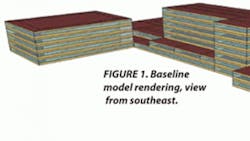Reducing Hospital CO2 Emissions With Condensing Boilers
In the United States, hospitals consume 836 trillion Btu of energy annually. In the process, they emit more than 30 lb of carbon dioxide (CO2) per square foot, more than 2.5 times the amount commercial office buildings emit. This represents 7 percent of total U.S. CO2 emissions (6,103 million metric tons CO2 equivalent).1
This article examines the effect of using condensing boilers as a means of reducing hospital CO2 emissions.
CO2-Emissions Modeling
CO2 emissions resulting from the burning of natural gas were simulated for three boilers:
- The 70-percent-efficient average existing boiler.2
- The 80-percent-efficient hot-water boiler required to meet ANSI/ASHRAE/IESNA Standard 90.1, Energy Standard for Buildings Except Low-Rise Residential Buildings.
- A 96-percent-efficient condensing boiler.
The standard hospital model from the reference buildings developed by the U.S. Department of Energy (DOE) in conjunction with Lawrence Berkeley National Laboratory, Pacific Northwest National Laboratory, and National Renewable Energy Laboratory (NREL) under the Commercial Building Initiative3 (http://1.usa.gov/benchmark_models) (Figure 1) was used.
CO2 emissions were simulated using the latest publicly available version of EnergyPlus (6.0.0.23), developed by the DOE and NREL.
Data were captured every 10 min for 365 days in 16 climate zones covering the spectrum of U.S. climate conditions for a total of 2,522,880 data points.
The figures on pages BSE8 and BSE9 illustrate the results of the simulations. Throughout all climate zones, CO2 emissions consistently were lowest with condensing boilers.
Beyond Environmental Effects: Dollars and Cents of Hospital Energy Use
Every year, U.S. hospitals spend an average of $1.67 per square foot for electricity and another 48 cents per square foot for natural gas. HVAC (45 percent) and lighting (25 percent) are the largest consumers of energy in a typical hospital. Both areas present opportunities for significant savings. According to the ENERGY STAR Financial Value Calculator (http://1.usa.gov/Financial_Value), a 5-percent reduction in a hospital’s energy use is equivalent to a 1-cent increase in earnings per share. Similarly, each dollar of energy saved is equivalent to a $20 increase in revenue.4 In aggregate, U.S. hospitals spend more than $5 billion—1 to 3 percent of a typical hospital’s operating budget, or an estimated 15 percent of profits—on energy annually.5
References
1) Chung, J.W., & Meltzer, D.O. (2009). Estimate of the carbon footprint of the US health care sector. The Journal of the American Medical Association, 302, 1970-1972.
2) Ware, M.J. (2000). Establishing an energy efficiency recommendation for commercial boilers. Retrieved from http://1.usa.gov/LBNL_Ware
3) Torcellini, P., et al. (2008). DOE commercial building benchmark models. Retrieved from http://1.usa.gov/Torcellini
4) Consortium for Energy Efficiency. (2005). Commercial building performance: Healthcare facilities. Retrieved from http://bit.ly/CEE_Healthcare
5) DOE. (2009, April 29). Department of energy announces the launch of the hospital energy alliance to increase energy efficiency in the healthcare sector. Retrieved from http://www.energy.gov/news/7363.htm
Sidebar: FACT MEETS FICTION
In a conventional boiler, fuel is burned, and the hot gases produced are passed through a heat exchanger, where much of their heat is transferred to water, raising the water’s temperature. One of the hot gases produced is water vapor (steam). A condensing boiler extracts additional heat from waste gases by condensing water vapor to liquid water (latent-heat recovery).
The effectiveness of the condensing process varies, depending on the temperature of the water returning to the boiler. For the same conditions, however, a condensing boiler always is at least as efficient as a non-condensing boiler. With condensing boilers, thermal efficiency of up to 98 percent can be achieved, compared with the 70 to 80 percent with conventional designs (based on the higher heating value of fuels).1
Condensing boilers can be used in almost any application requiring water at moderately warm temperatures. Radiant-floor-heating and water-source-heat-pump systems are two examples. Conventional space-heating applications with water temperatures of 150°F to 180°F do not produce condensing moisture. However, applying a temperature-reset control strategy and designing heat-transfer coils for larger temperature differentials will increase the combustion efficiency of a condensing-boiler system.2
Despite their superior efficiency, condensing boilers sometimes are avoided because of misconceptions concerning maintenance requirements and system cost.
Energy Saving Trust conducted an independent study in which it benchmarked condensing boilers and traditional boilers on cost, reliability, ease of installation, maintenance requirements, condensate drain, and exhaust requirements, among other parameters.3 The resulting report concluded there are no differences between the two boilers meaningful enough to justify the avoidance of condensing boilers. Current building regulations in the United Kingdom require all new gas and oil boilers to be condensing.
A more recent study of 20 K-12 schools in the United States4 found the replacement of traditional boilers with condensing boilers to be very favorable at a variety of gas prices. Also, it indicated condensing-boiler systems are safer to operate and maintain than traditional boiler systems.
References
1) Condensing boiler. (n.d.). Retrieved May 9, 2011, from http://en.wikipedia.org/wiki/Condensing_boiler
2) Turner, W.C., & Doty, S. (2009). Energy management handbook (7th ed.). Fairmont Press, pp. 114-115.
3) Energy Saving Trust. (2003). Domestic condensing boilers – the benefits and the myths. Retrieved from http://bit.ly/EST_condensing
4) Durkin, T.H. (2006, July). Boiler system efficiency. ASHRAE Journal, pp. 51-57.
The vice president of sales and marketing for Harsco Industrial Patterson-Kelley, Ramez Naguib, PE, LEED AP, CEM, has worked on large and sophisticated central cooling and heating projects around the world, including Africa, Asia, Australia, Europe, the Middle East, and North and Latin America.
Did you find this article useful? Send comments and suggestions to Executive Editor Scott Arnold at [email protected].
